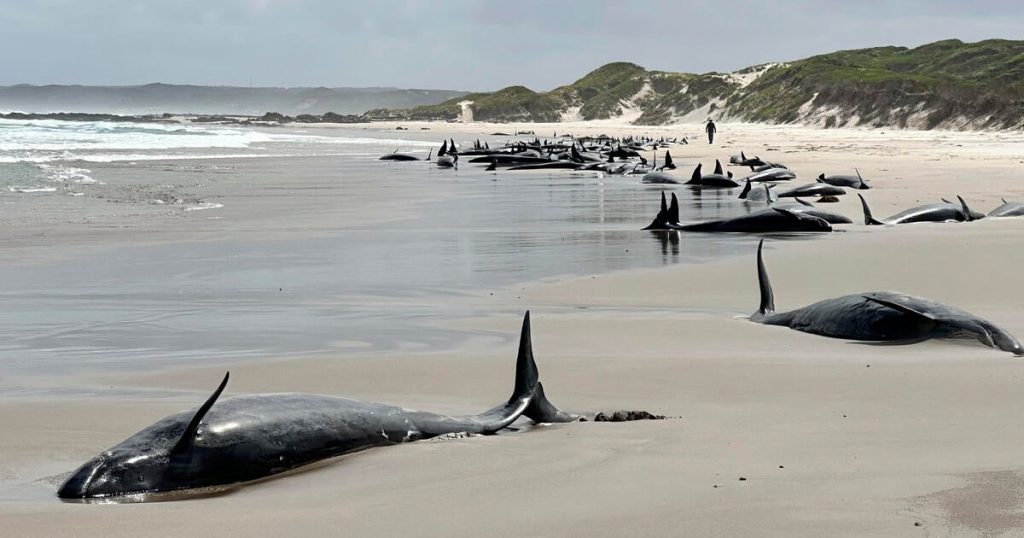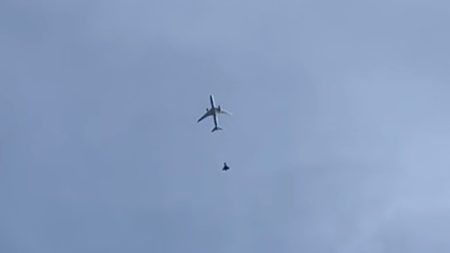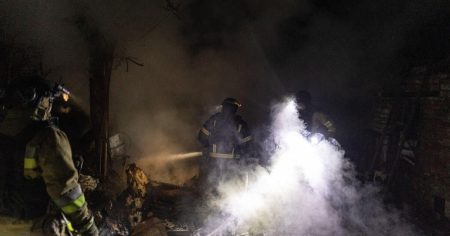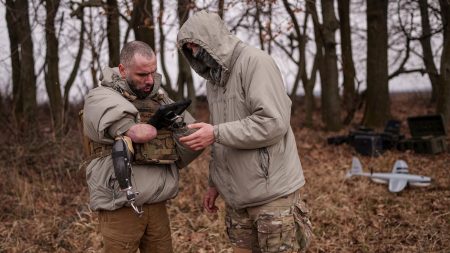A Devastating Marine Tragedy: The Stranding of False Killer Whales in Tasmania
The Incident: A Mass Stranding of Unprecedented Proportions
On Tuesday afternoon, February 19, 2025, a tragic marine event unfolded on a remote beach near the Arthur River in Tasmania, Australia’s island state. Marine experts and officials from the Department of Natural Resources and Environment Tasmania reported that over 150 false killer whales had stranded themselves on an exposed surf beach. By Wednesday, February 20, the situation had become dire, with rescue efforts hindered by unfavorable ocean and weather conditions. Incident controller Shelley Graham explained that despite attempts to refloat two whales, the challenging conditions made it impossible for the animals to navigate past the breakers. The whales repeatedly restranded, further complicating the rescue operation.
The remote location of the beach added to the difficulties, as accessing the area and transporting specialist equipment posed significant logistical challenges. The whales, ranging in weight from 1,100 pounds for younger individuals to over three tons for adults, were unable to survive the harsh conditions. Marine biologist Kris Carlyon acknowledged that the prolonged stranding had caused immense suffering for the animals, leading to the heartbreaking decision to euthanize the survivors. By Wednesday morning, only 90 whales were still alive, a stark decline from the initial count of 136 survivors.
The Rescue Efforts: A Race Against Time and Nature
The rescue operation was launched immediately after the discovery of the stranded whales, but the unpredictable ocean conditions and the whales’ repeated restranding made it nearly impossible to save them. Shelley Graham described the efforts of the rescue team, stating, "We have been out in the water this morning and have relocated and attempted to refloat two whales, but didn’t have success as the ocean conditions weren’t allowing the animals to get past the break. The animals are continuously restranding." The whales’ inability to stay afloat and the relentless pounding of the surf against the shore made the situation increasingly hopeless.
As the hours passed, the condition of the whales deteriorated rapidly. The young whales, in particular, were vulnerable due to their smaller size and the physical toll of being stranded for an extended period. The rescuers knew that time was running out, and with each passing hour, the likelihood of saving the whales diminished. By Wednesday afternoon, the decision was made to euthanize the remaining survivors to end their suffering. Marine biologist Kris Carlyon emphasized, "The longer these animals are out stranded, the longer they are suffering. All alternative options have been unsuccessful."
The Tragic Decision: Euthanasia and the End of Hope
The decision to euthanize the stranded whales was not taken lightly. It was a last resort, made after all other options had been exhausted. The whales had been stranded for at least 48 hours, and their physical condition had deteriorated significantly. The constant exposure to the elements, the stress of being stranded, and the inability to return to the water had all taken a devastating toll on their health. Marine biologist Kris Carlyon explained that prolonging their suffering was no longer humane, and the difficult decision was made to end their lives.
The euthanasia process was carried out with the utmost care and respect for the animals, ensuring that their suffering was minimized. While the decision brought an end to the whales’ ordeal, it also marked the end of a desperate rescue effort that had captured the hearts of many. The loss of so many false killer whales was a tragedy that resonated deeply with the local community and marine experts alike.
The Mystery Behind the Stranding: Unraveling the Causes
The exact reason behind the mass stranding of the false killer whales remains a mystery, and experts are working tirelessly to determine the cause. Strandings of this nature are often attributed to a variety of factors, including disorientation caused by loud noises, illness, old age, injury, fleeing predators, or severe weather conditions. However, in this case, officials have not speculated on the specific cause, choosing instead to focus on the immediate response and recovery efforts.
To shed light on the cause, experts will examine the carcasses of the whales for any clues that might explain why they stranded. A helicopter reconnaissance conducted on Tuesday afternoon revealed that there were no other whales within six miles of the stranded pod, ruling out the possibility of a larger group being affected. Arthur River resident Jocelyn Flint, whose son discovered the stranded whales while fishing for shark, described the scene as heartbreaking. "The water was surging right up, and they were thrashing. They’re just dying, they’ve sunk down in the sand," she said. "I think it’s too late. There are little babies. Up one end, there’s a lot of big ones. It’s sad."
A Rare Event with Historical Significance: Understanding False Killer Whale Strandings
The stranding of false killer whales in Tasmania is a rare and significant event. According to Brendon Clark, a liaison officer with the Department of Natural Resources and Environment Tasmania, this is the first recorded stranding of false killer whales in Tasmania since 1974. That incident involved a pod of more than 160 whales that landed on a beach near Stanley on the northwest coast. Strandings in Tasmania are more commonly associated with pilot whales, which have been involved in several mass strandings in recent years.
In early 2024, 29 long-finned pilot whales died, and about 100 more were rescued after they were beached along the lower tip of Western Australia. Tragically, the rescued whales re-stranded just hours later, resulting in the loss of all the animals. In 2023, nearly 100 pilot whales were stranded on a beach in Western Australia, with about half being rescued, only to re-strand and die. In 2022, 230 pilot whales stranded further south on the west coast at Macquarie Harbor, with only 35 surviving. The largest mass stranding in Australian history occurred in the same harbor in 2020, when 470 long-finned pilot whales became stuck on sandbars. Most of the beached whales died in that incident as well.
Conclusion: ACall to Action for Marine Conservation
The mass stranding of false killer whales in Tasmania is a stark reminder of the fragility of marine life and the challenges faced by conservation efforts. While the exact cause of this tragedy may never be fully understood, it highlights the importance of continued research and education into the behavior and health of marine mammals. By learning from such events, we can better equip ourselves to respond to future strandings and work towards preventing them.
The false killer whale, a member of the dolphin family, is a highly social and intelligent creature, with strong social bonds that tie pods together. The loss of so many individuals is not only a tragedy for the species but also a loss for the marine ecosystem as a whole. As we reflect on this heartbreaking event, we are reminded of the importance of protecting our oceans and the creatures that call them home. Through continued conservation efforts and a commitment to understanding and preserving marine life, we can hope to minimize the impact of such tragedies in the future.















